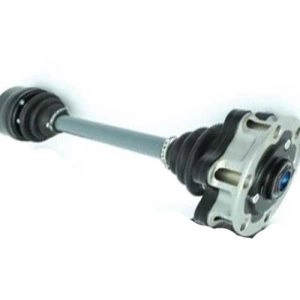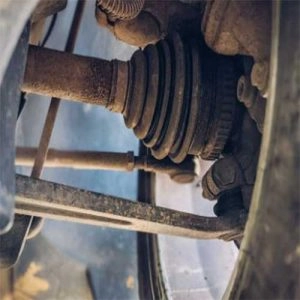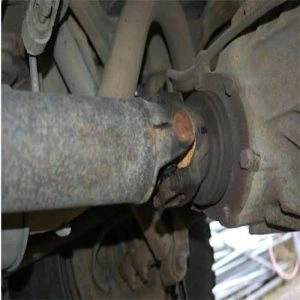The operation of a car is never a simple matter, but rather a very complex process that requires many parts to work together in harmony. If one of those parts encounters a problem, the car's operation will be disrupted, or at least annoying symptoms will appear to the driver, passengers, or both. The driveshaft is one of the essential parts that plays a critical role in moving the car. As many people do not know what this shaft is and its function, we decided to talk about it in this article, and explain the most prominent signs that indicate its damage.
What is the driveshaft?

The drive shaft, or rotating shaft, is a long rod designed to transfer torque from the transmission (also known as the gearbox) to the rear differential. It is present in cars with rear-wheel drive and four-wheel drive, while most front-wheel drive cars do not contain a drive shaft. Instead, there is a half shaft that transfers torque to the front wheels. Most often, there are some joints and carriers connected to the rotating shaft, the type of which is determined by the make and model of the car.
Types of drive shafts?

Found in rear-wheel drive cars.
Rear-wheel drive cars have a long driveshaft, one end of which is connected to the transmission, while the other end is connected to the rear differential. This is because in this type of car, the rear wheels, driven by the power of the engine, move the car. Moreover, the driveshaft is usually divided into two parts, and these two parts are connected to each other using a small component called a U-joint, which allows the driveshaft to move freely.
Found in four-wheel drive vehicles.
These vehicles are distinguished from rear-wheel drive cars by having a drive shaft instead of just one, as the power that propels the car is distributed to all four tires. They have a drive shaft equivalent to that found in rear-wheel drive cars, plus there's another shaft connected to the front differential.
While front-wheel drive cars do not have a long drive shaft, as all the essential components are at the front of the car, there is a half shaft instead of a long rotating shaft.
Also read: Car Failure Sounds: The Most Common Strange Sounds Coming from the Car and their Causes
Reasons for Drive Shaft Damage

There are numerous reasons that can lead to the damage of the drive shaft. We will mention some of them:
Firstly: The friction of the lower part of the car with the speed bump is one of the most important causes of breaking or bending of the drive shaft.
Secondly, the failure of the half-shaft bearing, which is one of the components of the rotating shaft, leads to an imbalance in the shaft.
Thirdly: The failure to lubricate the drive shaft cross at its scheduled time, which is after every 10,000 kilometers traveled.
Fourthly: Damage to the drive shaft universal joint, which can cause the car to flip, especially at high speeds.
Signs of Driveshaft Damage
The rapid movement of a healthy driveshaft leads to the rotation of the tires and the movement of the car. But what if this driveshaft was damaged? What would happen?
These questions have preoccupied many people who have searched for answers on the Internet, and it's time to answer them in this paragraph where we will highlight the top 3 signs indicating damage to the drive shaft. These signs are:
Difficulty steering the car.
If the drive shaft in your car is damaged, the most obvious sign you may notice is difficulty controlling the car; you won't be able to drive smoothly. Additionally, your car's tires may not respond correctly when attempting to turn, and it may feel like there's significant resistance to turning. This is because damaged linkages in the car prevent the tires from steering correctly. Of course, this serious issue cannot be ignored and must be addressed quickly. If you find it difficult to turn the steering wheel, it is advisable to check the condition of the power steering pump.
Vibrations at the bottom of the car
These vibrations are produced by the drive shaft, which vibrates due to damage to the joints. Therefore, vibrations coming from the bottom of the car are an indication of damage to the drive shaft. The issue should be resolved before it escalates, preventing further damage to the transmission and differential.
Noise
Also, loud noise is one of the most significant signs of drive shaft damage, and it can be added to the previous signs caused by damaged joints. This noise may appear when accelerating the car.
Is it possible to drive the car if the driveshaft is damaged?
This question may occur to many people, and given the symptoms of driveshaft damage we mentioned earlier, we do not advise anyone to drive a car if its rotating shaft is bad, or at least it is not preferred to drive for a long period of time. This is because if one part of the driveshaft gets disconnected, you may lose the power that directly drives the car. Furthermore, there is a high probability that the underside of the car may suffer severe damage in case of driveshaft failure. Most dangerous of all, the car could potentially flip in some cases.
Before concluding the article, we would like to highlight an important point, which is that when damage occurs.DriveshaftIt is not advisable to repair and weld it, but rather it is preferable to replace it entirely.

Comments